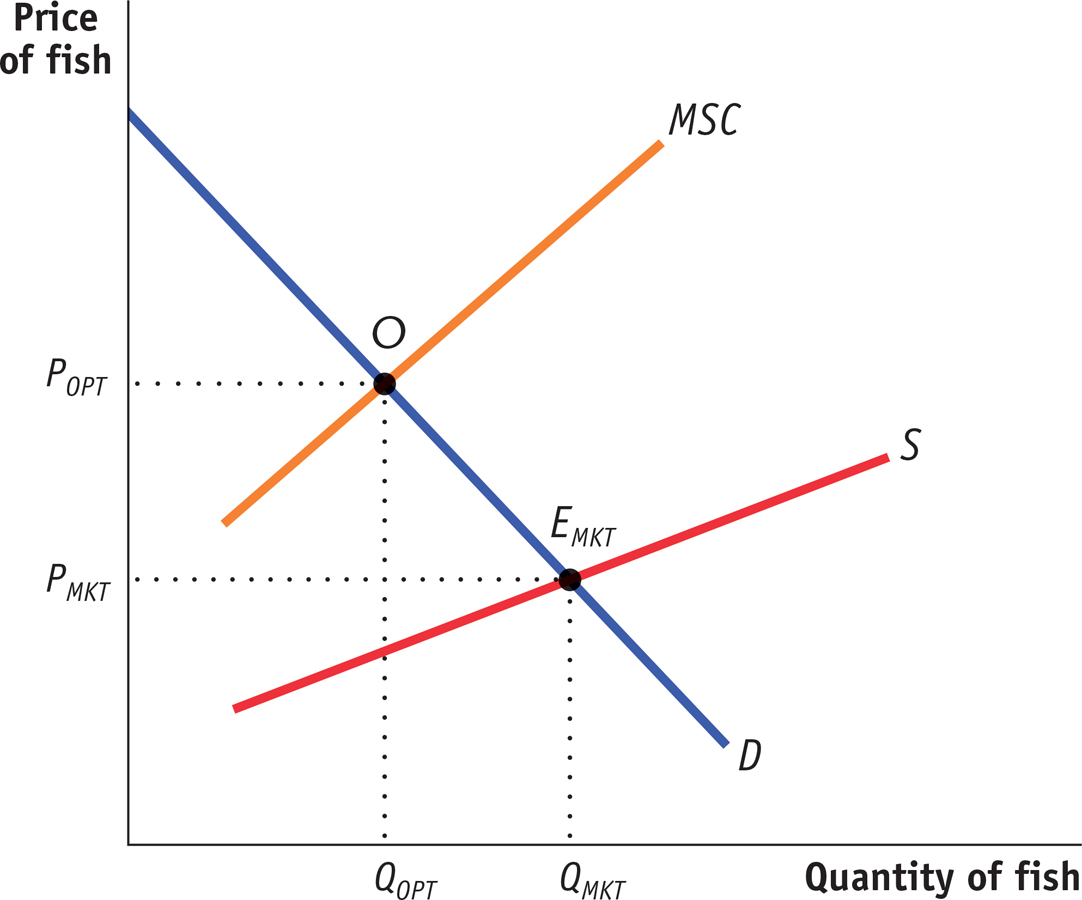The Problem of Overuse
Common resources left to the market suffer from overuse: individuals ignore the fact that their use depletes the amount of the resource remaining for others.
Because common resources are nonexcludable, individuals cannot be charged for their use. Yet because they are rival in consumption, an individual who uses a unit depletes the resource by making that unit unavailable to others. As a result, a common resource is subject to overuse: an individual will continue to use it until his or her marginal benefit of its use is equal to his or her own individual marginal cost, ignoring the cost that this action inflicts on society as a whole. As we will see shortly, the problem of overuse of a common resource is similar to a problem we studied in Chapter 16: the problem of a good that generates a negative externality, such as ground-
Fishing is a classic example of a common resource. In heavily fished waters, my fishing imposes a cost on others by reducing the fish population and making it harder for others to catch fish. But I have no personal incentive to take this cost into account, since I cannot be charged for fishing. As a result, from society’s point of view, I catch too many fish.
Traffic congestion is another example of overuse of a common resource. A major highway during rush hour can accommodate only a certain number of vehicles per hour. If I decide to drive to work alone rather than carpool or work at home, I make the commute of many other people a bit longer; but I have no incentive to take these consequences into account.
In the case of a common resource, the marginal social cost of my use of that resource is higher than my individual marginal cost, the cost to me of using an additional unit of the good.
Figure 17-3 illustrates the point. It shows the demand curve for fish, which measures the marginal benefit of fish—
17-3
A Common Resource

But the efficient outcome is to catch the quantity QOPT, the quantity of output that equates the marginal benefit to the marginal social cost, not to the fishing industry’s marginal cost of production. The market outcome results in overuse of the common resource.
As we noted, there is a close parallel between the problem of managing a common resource and the problem posed by negative externalities. In the case of an activity that generates a negative externality, the marginal social cost of production is greater than the industry’s marginal cost of production, the difference being the marginal external cost imposed on society. Here, the loss to society arising from a fisherman’s depletion of the common resource plays the same role as the external cost plays when there is a negative externality. In fact, many negative externalities (such as pollution) can be thought of as involving common resources (such as clean air).
When Fertile Farmland Turned to Dust
Ashley Yost’s grandfather sank a well deep underneath his prime Kansas farmland and struck a source of water so bountiful that he could pump 1,600 gallons to the surface every minute. Now fifty years later, his grandson is having trouble getting just 300 gallons of water per minute. And that water is so contaminated by sediment that tens of thousands of dollars worth of pumping equipment has been destroyed. As Mr. Yost ruefully remarked, “That’s prime land. I’ve raised 294 bushels of corn an acre before.... Now, it’s over.” In west-
This is the sad consequence of mismanagement of a remarkable common resource, the Ogallala Aquifer, one of the world’s largest underground reservoirs of water. It stretches across portions of eight Great Plains states and underlies approximately 174,000 square miles, supplying drinking water for millions of people. The water in the Ogallala Aquifer was deposited 2 to 6 million years ago when the Great Plains region was geologically active. As you might guess, water that was deposited millions of years ago cannot be replenished quickly. For the many parts of the Ogallala that are now dry, it would take over 100,000 years of rainfall to fill them back up.

How did this happen? The decimation of the Ogallala began in the 1950s with the large scale irrigation of Plains farmland with groundwater. The virtually unrestricted pumping of groundwater turned millions of acres of the semi-
While some areas in the northern Plains states still have enough ground-
Some farmers have given up all together, while others have switched to less thirsty crops or to livestock farming. Towns, industries, and recreation activities have all been affected. In Kansas, the state legislature has adopted a new set of water use regulations to encourage conservation, but, at the time of writing it is too early to determine their effectiveness. What we do know is that the days of ignoring a common resource like the Ogallala are over.